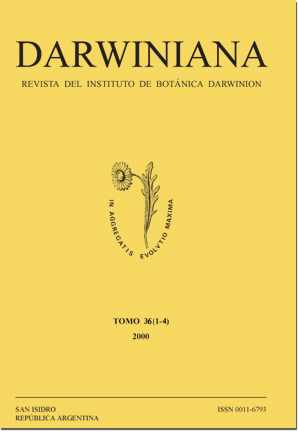Morphology of inflorescences in Lippia (Verbenaceae)
DOI:
https://doi.org/10.14522/darwiniana.2014.361-4.316Keywords:
Inflorescences, Morphology, Lippia, VerbenaccaeAbstract
This paper deals wilh the interpretation, description and typological characterization of inflorescences in the genus Lippia L. This genus comprises 160 species, mainly distributed in tropical and temperate America. with only a few species growíng in the Old World, of which 60 have been studied. The inflorescences are of compound polylelic type, with bracteate capituliform spikes as florescences. The phyllotaxis, form, size and colour of the bracts have taxonomic value, these characters correspond with the sections of the genus. In section Dipterocalyx, the inflorescences are bracteate or frondose-bracteale heterothetic pleiobotrya; in the remaining sections the inflorescences are homothetic pleiobotrya. Series Corymbosae and Paniculatae, and some species of section Dioicolippia, have bracteate or frondose-bracteate inflorescences, while the remaining sections have frondose ones. Section Goniostachyum and subsection Mexicanae have numerous paraclades per axile, while the other sections have 1-2 paraclades per axile. Section Pseudoaloysia (Lippia lasiocalycilla Cham.) is characterized by the production of flowers in two stages: first on bracteate brachyblasts with proliferation and the second on frondose macroblasts, which are originated by Ihe first brachyblasts. The heterothetic pleiobotra have been mentioned as the primitive form from which other inflorescences were derived. If this hypothesis is correet, the species of section Dipterocalyx may possibly be the ancestral group, from which the homothetic pleiobotrya of other sections derived.
Downloads
Published
How to Cite
Issue
Section
License

Starting on 2012, Darwiniana Nueva Serie uses Licencia Creative Commons Atribución-NoComercial 2.5 Argentina .






